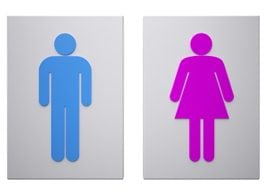New treatments for incontinence
Urinary incontinence is a source of embarrassment for many Canadians’but it’s much more common than you might think. Read on to find out why it happens and what new treatments can do for you

Source: Best Health Magazine, November/December 2010
As many as one in three women between age 41 and 64, and one in six under age 40, are dealing with a degree of urinary incontinence‘whether it’s a dribble when they cough or laugh, or a total loss of bladder control. Yet three quarters of these women don’t talk to their doctors about treatments’which has a real impact on their lives.
"Because they’re often too embarrassed to get help, many with incontinence stay home to avoid social events," says Linda Irving, nurse continence advisor at the Women’s Bladder Health Clinic. (The clinic, operated by the IWK Health Centre in Halifax, is a first for women in the Atlantic region. There are also clinics in Vancouver, Edmonton, Ottawa and other cities in Ontario, and Montreal.)
Women with incontinence are at greater risk of major depression because of the condition’s impact on their quality of life, say ‘University of Toronto researchers. The financial cost of incontinence is also high. The Canadian Continence Foundation, which supports education and research, estimates that women spend over a billion dollars on products like absorbent pads, often because they don’t believe medical intervention will help.
But there’s no reason to suffer in silence, says the foundation’s executive director, Jacqueline Cahill. ìIncontinence is definitely manageable, and very often curable. People have to start talking about it.î
Why it happens
Incontinence in women generally falls into one of three categories:
‘ Overactive bladder syndrome (also called urge incontinence), which occurs when your bladder muscles contract to create an urgent feeling even if your bladder isn’t full;
‘ Stress incontinence, which is when anything that puts pressure on the bladder, such as coughing or exercise, causes a leak due to weak pelvic and sphincter muscles; and
‘ Mixed incontinence‘a bit of both.
Many women unwittingly expose themselves to irritants that can make overactive bladder syndrome worse: caffeine, alcohol, spicy food, citrus juices, artificial sweeteners, cigarette tar and even chocolate. "Irritation of the bladder lining can set up an urgency feeling," says Jackie Wells, a pelvic dysfunction physiotherapist in Richmond, B.C. Being aware of triggers can help you control urgency.
Childbirth is a major cause of stress ‘incontinence among women in their 30s ‘and 40s. Pregnancy and childbirth can lead to gradual weakness of the pelvic floor, the muscles that support the bladder. Other causes of stress incontinence can include a chronic cough from asthma or smoking, or lifting and straining, including straining on the toilet. "Constipation is huge in this age range, and it influences incontinence significantly," Irving adds. Bladder infections do, too. Other factors include genetics, excess weight (which puts pressure on the bladder) and medications such as sedatives and drugs to control blood pressure (which can have side effects like relaxing the muscles that hold urine or causing increased urine production).
Treatment options
For total loss of control, or heavy wetting, there may never be a complete cure; the best choice may be disposable briefs (adult diapers). But for mild to moderate incontinence, which is far more common, there are options.
Trying to cope without medical advice could make things worse. "Many women cut back on fluids," says Wells. But concentrated urine can lead to an overactive bladder, whereas drinking plenty of water, which is good for you in many ways, can also help prevent bladder infections.
Other women may try to prevent accidents by going to the bathroom at every opportunity. "But they’re training the bladder to send the signal they need to pee even when it only has two or three ounces in it," says Wells. (A normal bladder holds 12 to ’16 ounces, or two cups).
Physiotherapists who specialize in urinary incontinence and doctors (gynecologists, urologists and some family doctors) can help. While not all treatment options are covered by provincial or private health insurance, it can be worth paying for help given the savings on incontinence products alone. "My patients say reduced anxiety over having an accident is priceless," notes Wells. Physiotherapists, she says, may charge $65 to $120 per visit.
Here are some treatment solutions your healthcare provider might suggest:
‘ Pelvic floor or Kegel exercises These can improve stress incontinence. Often recommended after women give birth, they involve strengthening the muscles supporting the bladder by systematically contracting and relaxing them. "When the exercises are done diligently, they can be successful up to 70 percent of the time," Irving says. But many women don’t use the right technique, or give up too soon (it can take three months to notice a difference). Your health professional can help you do Kegels properly. In fact, Australian research showed that pelvic floor exercise training with a continence physiotherapist can improve stress incontinence in about 80 percent of women, without drugs or surgery.
Also helpful are biofeedback machines that get signals from sensors inside or outside your vagina, telling you how well you’re doing Kegels and identifying muscle spasms; ask your doctor.
‘ Devices Your healthcare provider may recommend a pessary, which is a removable rubber or silicone insert that is placed inside the vagina to support the bladder. Check with your drugstore to see if it stocks them.
‘ Prescription medications Drugs such as Enablex and Ditropan can sometimes help relax an overactive bladder by blocking the nerves that control muscle contractions. But results vary, and many women stop the drugs because of side effects such as dry mouth and constipation.
‘ Diet and lifestyle changes These can make a big difference. Your specialist may recommend you cut back on bladder irritants such as caffeine and cigarettes, and learn how to prevent constipation (e.g., by eating more fibre) and bladder infections (e.g., by wiping from the front toward the back after going to the toilet).
‘ Bladder training Try putting off a bathroom trip by just a few minutes when you feel like you have to go, and then extend that interval by five minutes every few days. While you wait it out, you can try rapid ‘pelvic contractions or relaxation breaths ‘to calm the urge to urinate.
Surgical solutions
If other treatments fail, your specialist may recommend surgery. Most procedures treat stress incontinence. A tape procedure, for instance, involves supporting the urethra (the tube through which urine leaves the bladder) with a strip of synthetic material to help it stay closed when you’re not exerting pressure on the pelvic floor region. This surgery can be done on an outpatient basis. It works in 85 percent of women, but over time it will be less effective, and repeated surgeries have decreased success. Plus, there are risks with any surgery.
Collagen injected on the outside of the urethra may help by bulking up the tissue around it and keeping it closed. It’s successful in up ‘to 70 percent of women with stress incontinence. The collagen will be absorbed by the body after a year or two, says Irving, "but if it works and starts to fail, it can be repeated." And new treatments are in development.
Cahill encourages women to talk more openly about incontinence and seek help. That may also make you feel less alone. "There are a lot of people out there with the same problem," she says.
This article was originally titled "Under Pressure?" in the November/December 2010 issue of Best Health. Subscribe today to get the full Best Health experience ‘and never miss an issue!’and make sure to check out what’s new in the latest issue of Best Health




